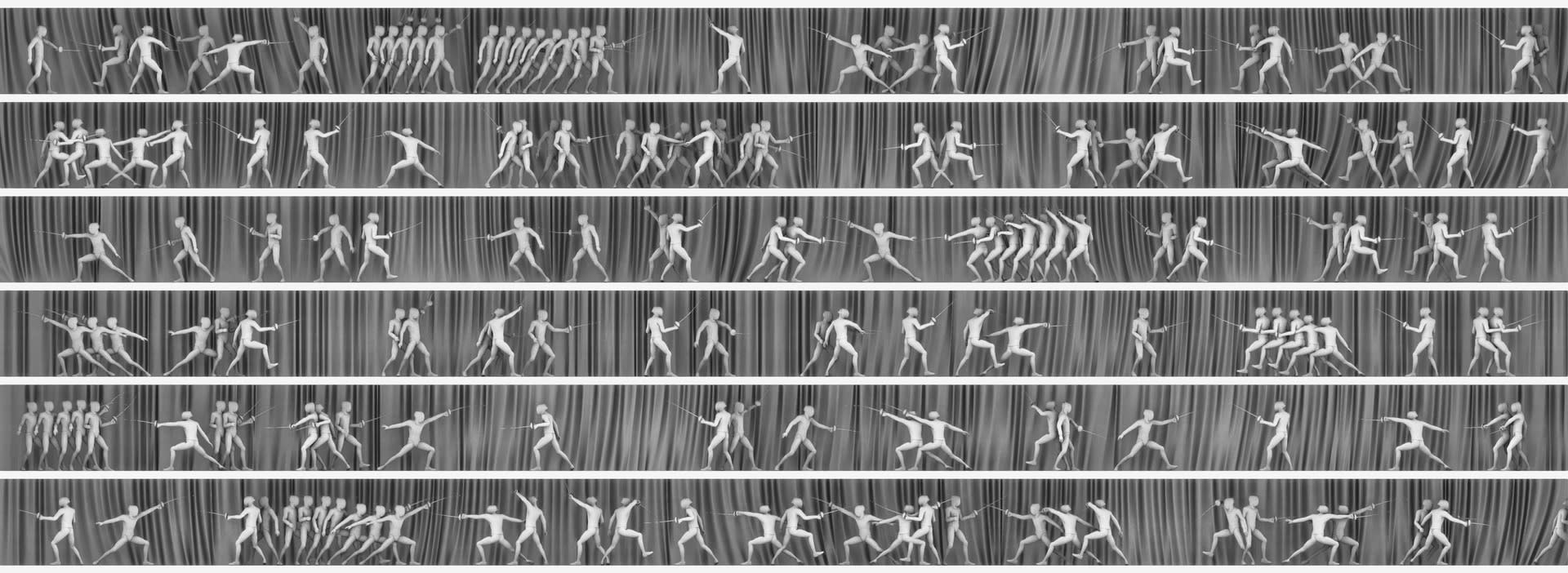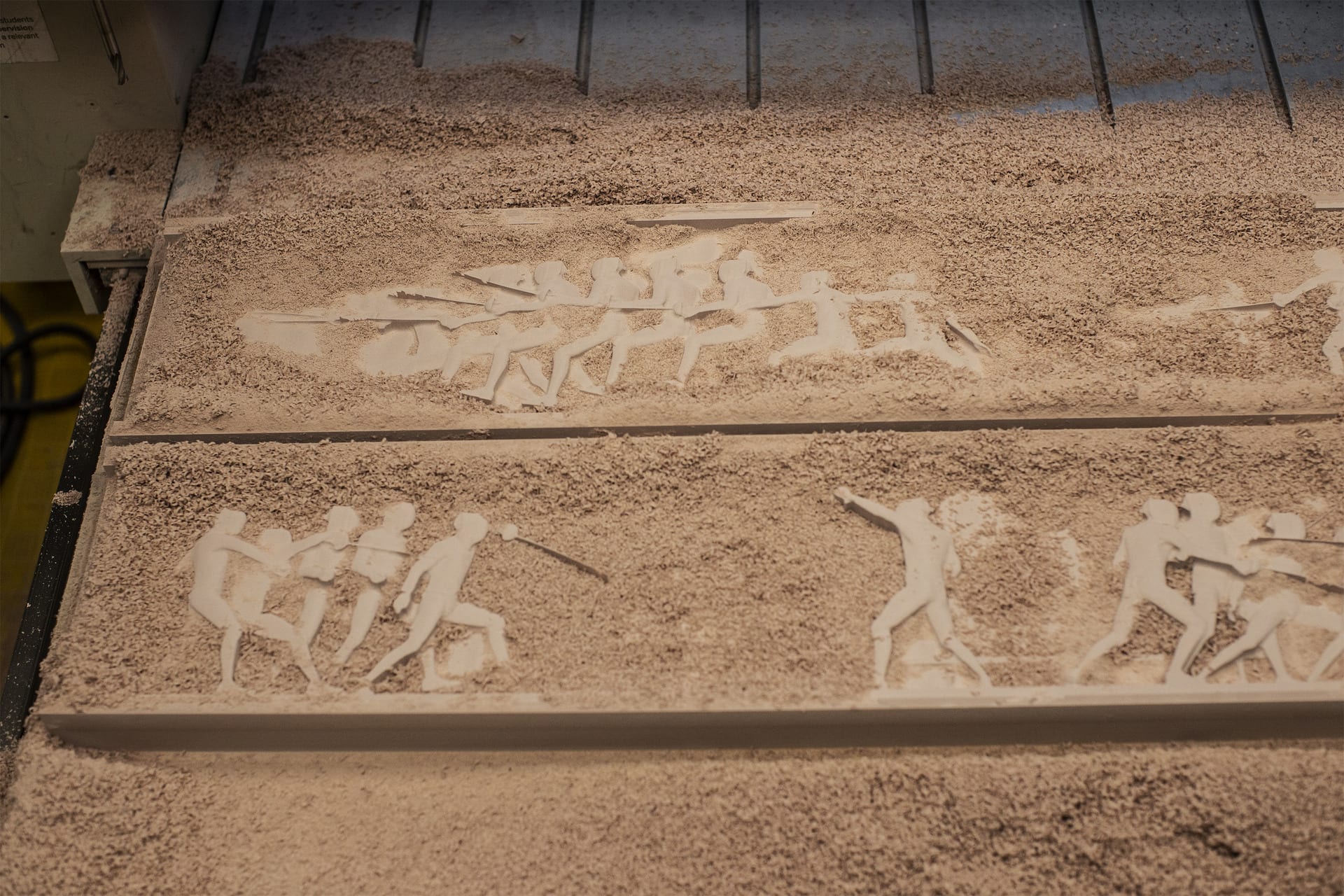12 June 2022
A.H The first question I’d like to ask is why ‘The Jewish Fencing Club’ title?
A.H I wanted a title that will give a certain ambiguity towards the existence of this club. So that the viewer may ask if it’s a real thing. The “The” suggests it is, but well, have you ever heard of such a club?
A.H Ok, so as a viewer I’m asking – does it actually exist?
A.H It existed once. About 100 years ago in Central Europe, many Jewish fencing clubs thrived. When I say thrived I mean Jewish fencers totally dominated the Olympic Games’ fencing finals. But today they’re all gone.
A.H So are you trying to bring them back to life?
A.H I wouldn’t say my work brings anything back to life. It’s more about trying to artificially resuscitate something that’s already dead.
A.H What does this mean in your practice?
A.H It means that I’ve re-enacted scenes based on archival imagery from these clubs. And I’ve also appropriated the kind of Modernistic aesthetics that ruled their visual culture at the time. I photographed myself in the spirit of early 20th century club posters – they were all very neo-classical in terms of the male body appearance, club members posing as mega-heroes etc.…
✡ ✡ ✡
A.H In your work, apart from you, who else did you photograph? Who are the dozens of figures carved in the frieze? And in the video I can count 10 masked fencers, who are they?
A.H They are all myself or based on a motion capture of my body.
A.H Why do you only use your own body? No other volunteers?
A.H Yeah people are difficult to persuade! But to be serious, I wanted to amplify the emptiness of the club. You see, it is only me standing there alone.
A.H But I see many figures! In your video and frieze, the club is full of fencers, full of movement.
A.H That is because you’re experiencing photography in action. Photography manipulates loss, it claims to fill magically the void that time may leave behind. Here, I’ve used photographic duplication and motion capture to fill the club with human presence and movement.
A.H Isn’t that resuscitation in a way, performing a scene of a lively club?
A.H Sadly no. The fencers in the old images I saw are still dead.
A.H Maybe your work is a monument? An abstract empty club monument. I’ve never heard of that, usually they're made from stone or bronze.
✡ ✡ ✡
A.H Ouch! You just stabbed me!
A.H No I didn’t. I merely touched you with the tip of my blade.
A.H Well I felt it. That was aggressive.
A.H I disagree, I would argue that it isn’t violence but rather an act that symbolizes violence – A gesture holding within it a memory, resembling a penetrating act.
A.H Ahh you’re unbearable. Symbolize your violence on someone else. What are you trying to say?
A.H I’m trying to demonstrate why I am using fencing as a central methodology in my project.
A.H Because it’s an activity that’s based on symbolism? On restrained violence?
A.H Yes, it has a memory embedded within its structure, one of an ancient bloody activity. Imagine gladiators covered in blood or gentlemen with horrible scared faces. Now modernism took these blade atrocities and transformed them into an elegant clean sport, that looks almost like a mating dance. Touch and body-gestures now replace stabbing. Minimal body movements, like a subtle leaning forward – may be interpreted by the referee as a successful attack.
A.H And how does this relate to our club project?
A.H The reason I’m recalling this forgotten Jewish heritage is to think about the role of the body in shaping a wider set of ideas. In other words, one can always find traces of body-image and gender issues behind mega ideologies such as nationalism. We tend to forget how our bodies are the closest thing to us; everything passes through them.
A.H That sounds very abstract.
A.H Yes I know. But looking into the Jewish fencing clubs can really make it visible.
A.H How exactly?
A.H Because we can learn how the Jewish body-image took part in shaping people’s national identity. At the time, many of the club members were not only aspiring for an ideal masculine body, but this body had to be a correction and a replacement of another, shameful one.
A.H Correction?
A.H Yes. At that time and for hundreds of years before, the Jewish male body was portrayed by antisemites as feminine, weak, impotent, and even as one that undergoes a menstrual cycle. These gender-based 'accusations' had an impact on Jewish national thinkers such as Max Nordau, a figure who was a hero for many young Jewish men in early 20th century Central Europe. Nordau was obsessed with the 'correct' body that the new Jewish man should have, in correlation to the new nation that was about to be born. He called this idea 'Muskeljudentum' – Muscular Judaism.
A.H And you’re saying that behind these muscles, lay a self-body-image that was inevitably influenced by its oppressor’s conceptions? That a negative body-image was unwillingly adopted by the oppressed?
A.H Precisely.
A.H Just to be annoying again – how does this discourse operate through our work?
A.H The bodies are performing it – in the video they are standing almost still in front of a blue screen, waiting to be photographed. Their posture is passive and no fencing blades are present. In a way – it is a group photo of an impotent fencing club, drained of power. Their bodies are trapped in a state of being photographed, being shaped by the viewer.
A.H And in the cast frieze?
A.H The frieze suggests something else. It is full of frozen and yet dynamic motion, heroic motion. But on looking closer, the viewer may notice that the figures are all identical and in fact a duplication of one – of a lonely castrated fencer. His blade cuts the air only, it never collides.
A.H I understand. On another point, why choose the medium of relief? Isn't it a bit old-fashioned?
A.H It is. In comparison to a 3D sculpture, a relief has basically one ideal viewpoint. That's why it was used in history as an effective and direct narrative storyteller. However, in The Frieze there is no linear story on the surface. The movement of the fencers is multi-directional and full of mysterious gestures. It seems that their story is broken.
✡ ✡ ✡
A.H Last question - in the frieze I see benches. What are they doing there?
A.H They’re there as a memory, but a very specific one of my own. When I began the project I enrolled for fencing classes. I imagined they would take place in a beautifully decorated hall with velvet curtains covering the walls, and that I would be storing my fencing gear in 19th century wooden wardrobes. Instead, I found myself in a secondary-school sports hall, with typical low benches and the smell of sweating people in thick fencing gear. Not how I fantasized it.












